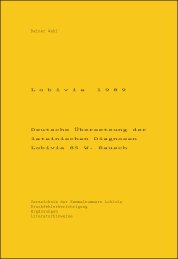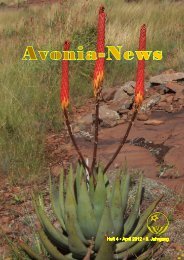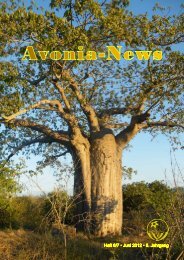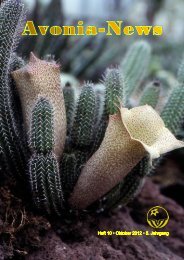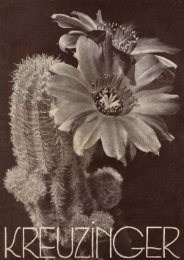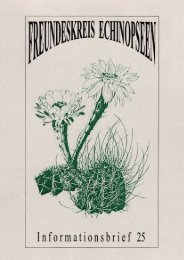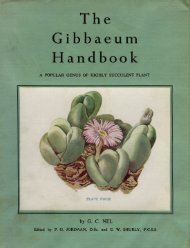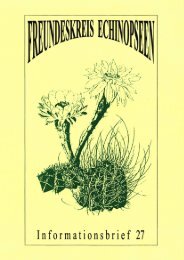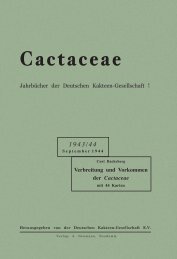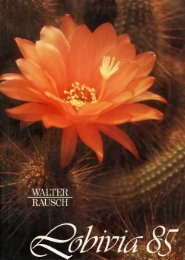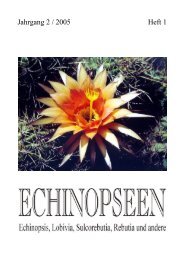Lithops - Au Cactus Francophone
Lithops - Au Cactus Francophone
Lithops - Au Cactus Francophone
You also want an ePaper? Increase the reach of your titles
YUMPU automatically turns print PDFs into web optimized ePapers that Google loves.
lau”. > blau.<br />
He goes on to say that L. summitata is “hellgrau blau am Kegelteil” and L.<br />
karasmontana “taubengrau blau.” This assumes that there is a definite colour<br />
called taubengrau blau. It is clear that these fine differences in colour cannot<br />
possibly be used to distinguish species. Dr. Geyer, who had collected L. kara‑<br />
smontana and the so called L. summitata, was asked by me to divide his fresh<br />
material into as many groups as he could, based on the difference in colour of<br />
the top surface. He found seven groups all more or less connected with one<br />
another (Fig. 11). If one mixed them and were asked to pick the members<br />
of the various groups, a different grouping would result in which the groups<br />
would not contain the same plants as before. Dinter asserts that the weight of<br />
the seed of L. summitata is 0.072 mg. and that of L. karasmontana is 0.064 mg.<br />
That is driving the art of distinguishing species to a very fine point indeed.<br />
To my mind there is only one species L. karasmontana, and I have come to<br />
this conclusion after examining plants from each of two localities in which<br />
L. karasmontana and L. summitata were found.<br />
24<br />
KEY FOR DETERMINING THE SPECIES<br />
Only a few words are necessary concerning the key submitted here. As<br />
has already been stated the flower is of no help in the delimitation of spe<br />
cies in the genus. One is therefore reluctantly compelled to use the nature<br />
and colour of the upper surface of the leaves for purposes of classification,<br />
although it is realised that the key based on one organ and that the leaf<br />
can never be entirely satisfactory.<br />
The genus can conveniently be divided into two sections; (I) Afenestra‑<br />
tae and (II) Fenestratae.<br />
The first group consists of all those species in which the upper surface<br />
appears to be opaque though in reality it lets enough light through for the<br />
plants to thrive. The species of this group, with the exception of L. Meyeri, L.<br />
turbiniformis, L. divergens, L. verruculosa and L. Van Zylii, are all found north<br />
of the Orange River and are inhabitants of South West Africa. With the<br />
exception of L. divergens they all grow in the neighbourhood of the Orange<br />
Riser itself.<br />
The second group Fenestratae includes those species in which the upper<br />
surface is either entirely transparent or is perforated by transparent pellucid<br />
area. The key will unfortunately not enable one to determine satisfactorily<br />
certain species and in that case use should be made of the photographs and<br />
coloured plates. In the case of some species the differences are quite obvious,<br />
if the plants are placed alongside one another, but it is very difficult if not<br />
impossible to describe these differences in words.<br />
Ernst Rusch, an enthusiastic collector of succulents in South West Af<br />
rica, found on examining seedlings of <strong>Lithops</strong>, that he could divide them into<br />
two distinct groups, viz.; (A) the fissure is localised in the form of a small<br />
aperture in the centre of the two leaves, and (B) the fissure separates the



